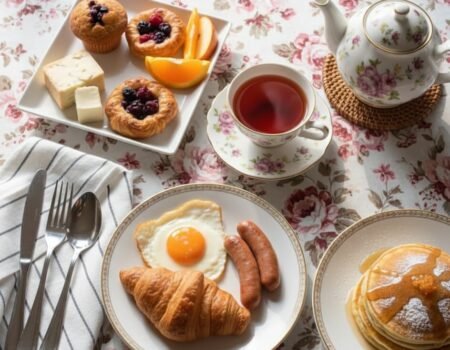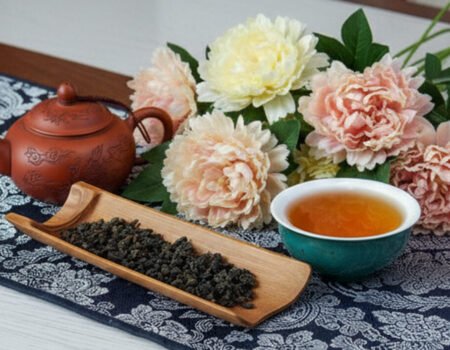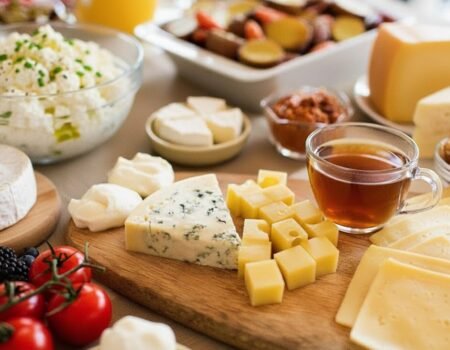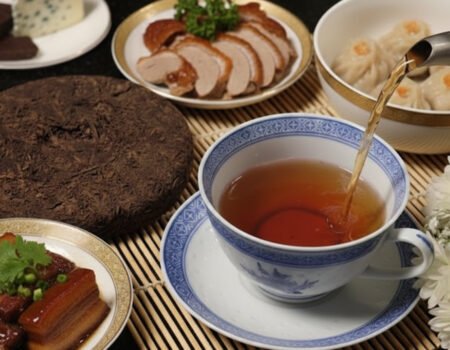
Yixing Teaware: The Art of Clay Teapots and Zisha Tea Vessels
Index
Yixing teaware, made from special zisha clay found only in China’s Jiangsu province, has been prized by tea experts for over 500 years.
This guide will explain how these unglazed clay teapots work, which teas pair best with them, and how proper care creates a personal tea vessel that improves with age. Discover why these purple clay masterpieces remain the top choice for serious tea drinkers worldwide.
Key Takeaways
- Yixing teapots are made from special zisha clay found only in China’s Jiangsu province and have been valued by tea experts for over 500 years.
- These unglazed clay teapots absorb tea oils over time, creating a unique patina that enhances flavor. Each pot should brew only one type of tea throughout its lifetime.
- Different clay types (purple, red, green, and yellow) pair best with specific teas – purple clay works well with pu-erh, while red clay enhances black teas.
- Proper care includes rinsing with hot water only (never soap), complete drying between uses, and seasoning new pots by boiling them in water for 30 minutes.
- Unlike glazed ceramics, Yixing teapots maintain better heat stability, develop flavor memory, and create a personal connection that improves with age.
Decoding Yixing Teaware: Origins and Core Material

Yixing teaware holds a special place in tea culture with roots dating back to China’s Song Dynasty. Zisha clay, mined near Yixing city, contains unique minerals that shape these prized teapots and vessels.
Historical Background and Significance
Zisha teapots trace their roots to Yixing County in Jiangsu Province, China, with a history spanning about 5,000 years. These purple clay vessels gained major attention during the Ming Dynasty (1368-1644), starting their journey at a small temple in Yixing.
Chinese scholars and artists prized these teapots for their unique properties and elegant designs. The special clay absorbed tea flavors over time, making each pot more valuable with use.
Local artisans developed special techniques to shape this distinctive material into functional art pieces.
The global fame of zisha teaware expanded during the Qing Dynasty as trade routes opened. Tea connoisseurs discovered that different clay types enhanced specific tea varieties. The purple sand clay became known for its ability to maintain heat and improve tea flavor.
Ming Dynasty literati wrote poems and essays about these teapots, cementing their place in Chinese tea culture. Today’s zisha craftspeople blend ancient methods with new ideas, creating pieces that honor this rich heritage while appealing to modern tea drinkers.
The unglazed surface of these teapots continues to tell stories of China’s long relationship with tea.
Fundamental Properties of Zisha Clay

Beyond its rich history, Zisha clay stands out for its remarkable physical traits. This special clay formed about 350 million years ago contains a mix of quartz, kaolin, mica, hematite, and iron.
These elements give Yixing teapots their famous durability and heat resistance. The porous nature of unglazed Zisha allows tea oils to seep into the clay over time, creating a natural seasoning that many tea lovers prize.
Traditional Zisha processing takes several years and involves multiple steps. Craftsmen weather the raw ore, grind it into fine powder, and mix it with water to create workable clay.
The clay comes in various natural colors including brown, red, black, green, and white. Each type offers unique properties for brewing specific teas. The high firing temperature creates stonewares that maintain stability during rapid temperature changes, making Yixing teapots perfect for gongfu brewing styles.
Understanding Different Yixing Clay Types

Yixing clay divides into three primary families, each offering distinct brewing characteristics that transform your tea experience. These foundational clays—purple, red, and beige—form the backbone of authentic Yixing teaware, with each type developing through centuries of refinement by master potters.
Purple Clay (Zini) stands as the most versatile family, producing teapots with balanced porosity perfect for oolong, black, and pu-erh teas. You’ll find this clay develops a subtle patina over time, enriching the depth of your chosen tea. We’ve observed that purple clay teapots offer exceptional adaptability, making them ideal for tea enthusiasts exploring multiple tea styles.
Red Clay (Hongni) encompasses several varieties, with Zhuni being the most celebrated sub-type. This fine-textured clay features lower porosity than purple clay, concentrating tea aromas while maintaining bright flavor notes. Your oolong teas will particularly benefit from Zhuni’s heat retention properties and smooth interior surface.
Beige Clay (Duanni) presents a more porous structure with distinctive yellow-beige coloration after firing. The enhanced breathability of this clay makes it particularly suited for pu-erh teas, where you’ll notice how it softens harsh notes while preserving the tea’s characteristic earthiness. We recommend Duanni for tea drinkers who appreciate how clay interaction can mellow and round their brews.
Beyond these three families, several rare clays capture collectors’ attention.
Black Clay (Heini) achieves its striking ebony appearance through either mineral additives or specialized reduction firing called “wuhui.” True original-ore Heini remains exceedingly scarce, with authentic deposits exhausted decades ago—most black teapots today derive their color from treating purple or red clay bases.
Tianqing Clay (Tianqingni) displays unique greenish-purple hues when fired, representing another historically prized variety now rarely seen in modern production.
Selecting and Using Yixing Teapots
Choosing the right Yixing teapot shapes your entire tea journey. Each pot has specific traits that match certain teas and brewing styles.
Ideal Tea Pairings for Yixing Clay

Yixing teapots create special bonds with the teas they brew. The porous zisha clay absorbs tea oils and aromas over time, making each pot uniquely suited for specific tea types:
• Ripe Pu-erh performs best in thick-walled Yixing teapots with high porosity. These sturdy vessels maintain heat while allowing the earthy, deep flavors to develop fully during gongfu brewing.
• Delicate white, green, and yellow teas benefit from flat Yixing teapots with thinner walls. This design prevents over-extraction while enhancing subtle notes.
• Rolled oolong teas pair wonderfully with round-shaped vessels. The spherical form brings out natural sweetness and allows leaves to unfurl gracefully.
• Dark oolongs like Wuyi varieties match perfectly with taller teapots. The height creates ideal space for bold flavors and roasted notes to release.
Each Yixing teapot should brew only one type of tea throughout its lifetime. This dedication allows the unglazed zisha clay to build a rich patina that enhances future brews of that specific tea. You’re essentially creating a partnership between pot and tea that deepens with every session. The specific clay type you choose further shapes this relationship.
Matching Clay Types to Your Tea
• Hongni (red clay) works exceptionally well with black teas and darker oolongs. The iron-rich clay brings out depth and sweetness in these stronger teas.
• Zini (purple clay) complements aged pu-erh and heavily roasted oolongs. This classic purple sand material preserves heat well and draws out rich, mature flavors.
• Duanni (yellow clay) highlights floral notes in lighter oolongs and some green teas, creating smoother texture in the cup.
Quality matters significantly with Yixing teapots. Fully handmade versions often provide better brewing results than half-handmade or slip-cast alternatives. The craftsmanship affects how tea flows and develops inside the pot, influencing everything from heat retention to flavor extraction. Most experts suggest avoiding brewing light teas like green or white varieties in Yixing clay altogether—porcelain or glass often serves these delicate leaves better than even the finest zisha.
Teapot Shapes and Their Functional Relevance
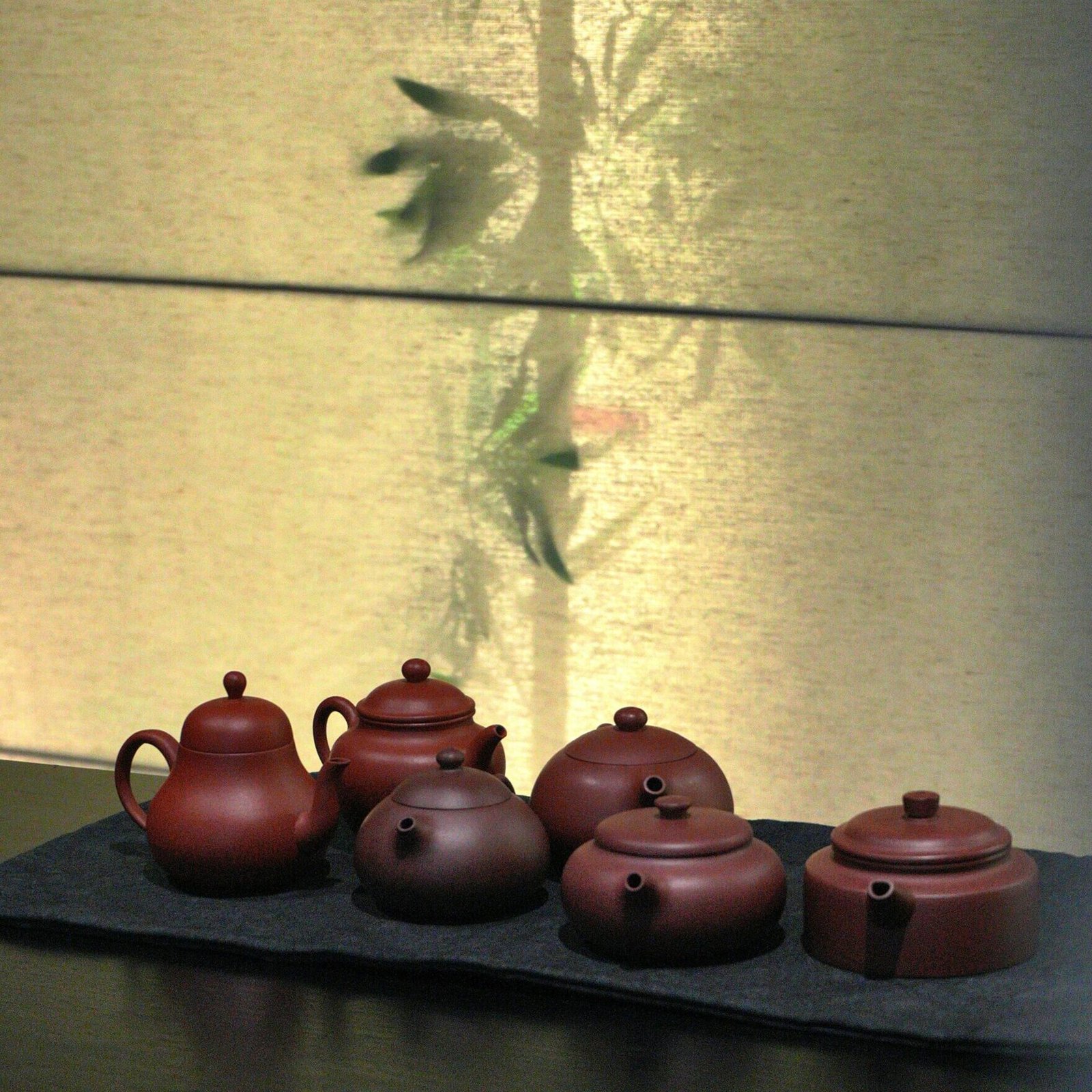
Beyond matching teas with clay types, the shape of your Yixing teapot plays a crucial role in brewing results. Teapot designs directly impact tea quality through their structure and function.
The popular Ju Lun Zhu style pots feature balanced proportions that allow smooth pouring and better brewing. Round teapots bring out the sweetness in rolled oolong teas by giving leaves space to unfurl fully.
Flat teapots with thin walls work best for delicate teas like white, green, and yellow varieties. These designs help control temperature and extraction rates more precisely. Each shape serves a specific purpose in gongfu cha preparation.
The right pot shape enhances your tea’s flavor profile while making brewing easier. Tea masters select shapes based on both practical brewing needs and the specific character of the tea being served.
Yixing teapots absorb tea oils over time, which means your pot’s shape becomes even more important as it develops its unique patina.
Key Usage Principles: Dedication and Gongfu Brewing
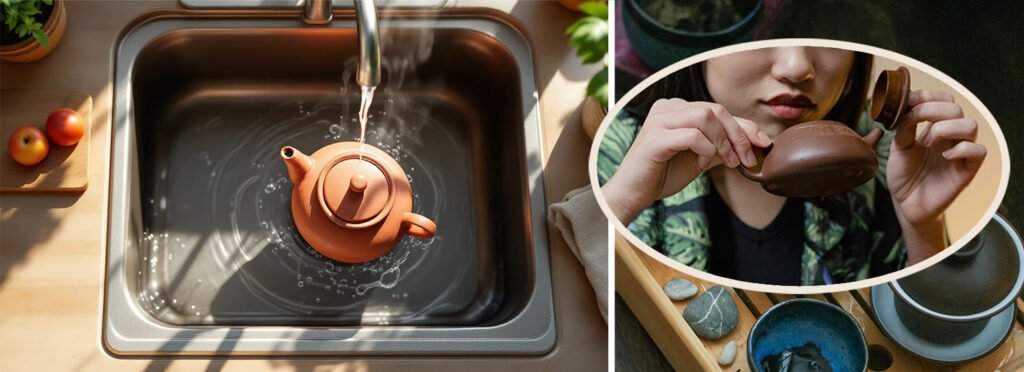
Yixing teapots demand specific practices to unlock their full potential. These unglazed clay vessels absorb tea oils and develop unique character through proper use.
Core Dedication Principles
• Dedicate each Yixing teapot to one tea type. The porous zisha clay absorbs flavors from each brew, creating a memory that enhances future cups of the same tea.
• Match dark teas like pu-erh with more porous clay types. The clay’s natural properties complement specific tea varieties, making thoughtful pairing essential for optimal results.
• Rinse your teapot with hot water before and after each use. This simple step maintains cleanliness without soap that could strip away the developing patina.
• Allow your teapot to dry completely between uses. Air circulation prevents mold growth and preserves the integrity of your zisha ware.
• Handle your teapot with clean hands. Natural oils from your skin can interfere with the intended patina development.
Gongfu Brewing Techniques
• Use gongfu brewing to maximize your Yixing teapot’s benefits. This Chinese method employs higher leaf-to-water ratios and shorter steeping times for multiple infusions.
• Fill your teapot only 70-80% full. This gives tea leaves space to expand and release their full flavor profile during brewing.
• Pour hot water over the outside during sessions. This practice helps maintain consistent brewing temperature inside the pot throughout your gongfu cha ritual.
Traditional tea culture includes elements like tea pets—clay figurines that receive the first rinse of tea as part of the ritual. These companions often sit alongside Yixing teapots in authentic setups. You’ll want to avoid brewing herbal tisanes in your dedicated Yixing pot, as residual oils from herbs will mix with your tea’s flavor profile and compromise the pot’s dedication to its chosen tea type.
Comprehensive Care for Your Yixing Teapot

Proper care of your Yixing teapot creates a lasting bond between you and your tea vessel, as daily cleaning, seasoning, and patina development all play key roles in keeping your teaware in top shape for years to come – discover the secrets to making your purple clay teapot more beautiful with each use!
Daily Cleaning and Drying Practices

Proper care extends the life of your Yixing teapot and enhances its unique properties. These simple daily practices will help maintain your zisha vessel’s quality and develop that coveted patina tea lovers prize.
Immediate After-Use Care
• Rinse your Yixing teapot with hot water after each use. This removes tea residue without soap, which can damage the clay’s natural properties.
• Empty all tea leaves promptly after brewing. Leaving leaves prevents mold growth and unwanted flavors in future brews.
• Use a soft bamboo brush for hard-to-reach areas. Gentle cleaning preserves your purple clay teapot’s interior surfaces.
• Pat the exterior dry with a clean cloth. Quick moisture removal helps maintain the clay’s integrity.
Your teapot needs proper drying to prevent damage and preserve its developing character. Air dry your teapot with the lid off to allow complete evaporation of moisture from both pieces. Place it in a well-ventilated area away from direct sunlight during the drying process—direct sun can cause uneven drying and potential cracking.
Storage and Long-Term Care
• Store your dried teapot away from strong kitchen odors. Unglazed Yixing clay absorbs surrounding scents easily, which could affect your tea’s flavor.
• Keep your teapot in stable humidity conditions. Consistent environment prevents clay deterioration over time.
• Handle with clean hands only. Oils from skin transfer to the clay surface and interfere with patina development.
Avoid sudden temperature changes that might stress the clay structure of your handmade teaware. You’ll also want to check occasionally for mineral deposits that may form, especially if you use hard water for brewing. These deposits can affect both the appearance and performance of your Yixing teapot over time.
Seasoning New Yixing Ware

Yixing teapots require proper preparation before their first use. Seasoning removes unwanted odors and begins the patina development process that makes zisha teaware so special.
Initial Preparation Steps
• Fresh Yixing teapots often have earthy or fishy smells. These scents from the unglazed purple clay must be removed through proper seasoning techniques.
• Fill a large pot with clean water and submerge your teapot completely. Include the lid and ensure water covers the teaware by at least two inches.
• Bring the water to a gentle boil for about 30 minutes. This process helps remove impurities and manufacturing residues from the zisha clay.
You can enhance the seasoning process by adding tea leaves to the boiling water. Many tea enthusiasts use the same tea type they plan to dedicate their teapot to during this step, creating an early bond between pot and tea. After boiling, allow the teapot to cool naturally in the water—this gradual cooling prevents thermal shock to the clay body.
Finishing the Seasoning Process
• Rinse the teapot thoroughly with fresh water once cooled. The clay should now feel smoother with harsh odors significantly reduced.
• Dry your teapot completely before first use. Place it in a well-ventilated area away from direct sunlight until no moisture remains.
• Never let soap or detergents touch your Yixing teapot. These substances penetrate the porous clay and affect tea flavor permanently.
Some collectors perform an additional tea infusion seasoning. This involves brewing strong tea in the pot and letting it sit overnight to further prepare the clay. Once properly seasoned, your Yixing teaware pairs perfectly with gongfu brewing techniques. The clay will begin absorbing tea oils with each use, enhancing future brews and developing that prized patina unique to your pot.
Long-Term Care: Patina Development and Addressing Issues

Patina growth on your zisha teapot happens through proper tea brewing, not just from pouring hot water into an empty vessel. High-quality Yixing clay shows unique properties—low wet-ability when cool but excellent absorption at high temperatures.
This creates the perfect environment for tea compounds to interact with minerals in the clay. Larger, flatter teapots often develop patina faster because they maintain heat better during brewing sessions.
Your teapot’s shine might appear in weeks or take years to develop fully. Some pots never show dramatic changes despite regular use. Try buffing your pot with a soft cotton cloth after a month of gongfu brewing to enhance its natural luster.
Tea stains alone don’t create true patina—it’s the complex interaction between your brewing technique, the specific tea type, and the unique properties of your purple clay vessel that builds character over time.
Yixing Teaware in Context: Comparison with Glazed Ceramics

Yixing clay and glazed ceramics represent two distinct approaches to tea brewing vessels. Each material offers unique benefits that affect tea preparation and taste in different ways. The choice between them depends on your brewing style, tea preferences, and maintenance habits.
| Feature | Yixing (Zisha) Teaware | Glazed Ceramics |
|---|---|---|
| Material Composition | Unglazed clay with high iron content | Clay body covered with glass-like coating |
| Porosity | Porous surface absorbs tea oils and aromas | Non-porous surface prevents absorption |
| Heat Retention | Superior heat stability maintains brewing temperature | Variable retention based on thickness and material |
| Flavor Development | Builds flavor memory over time, enhancing tea character | Neutral effect on flavor; no memory effect |
| Tea Versatility | Best dedicated to one tea type | Can brew multiple tea types without flavor transfer |
| Maintenance | Requires specific care routines; no soap | Easy to clean; dishwasher safe in many cases |
| Brewing Method | Ideal for Gongfu brewing with high leaf ratios | Suitable for various brewing styles |
| Aging Potential | Develops beautiful patina and improved brewing over years | Appearance remains consistent with proper care |
| Thermal Shock Resistance | Withstands rapid temperature changes | More susceptible to cracking from thermal shock |
| Best Tea Pairings | Oolong, pu-erh, and black teas | Green, white, yellow teas, and herbal infusions |
Many tea enthusiasts collect both types of teaware. Zisha clay vessels excel at bringing depth to darker, more robust teas through their unique ability to absorb and enhance flavors. Glazed pieces shine with delicate teas where clarity and brightness matter most. Your perfect teapot depends on which qualities you value most in your tea experience.
Conclusion

Zisha teapots stand as living artifacts that connect us to centuries of tea tradition. These special vessels transform with each brewing session, developing unique character while enhancing tea flavors through their porous clay bodies.
The dedication of a single tea type to each pot creates a personal journey between tea lover and teaware. Learning proper care techniques ensures your teapot will serve many generations, growing more valuable with age.
Whether you choose duanni, hongni, or classic purple clay, these remarkable companions offer both practical function and artistic beauty to elevate your daily tea ritual.
FAQs

1. What is Yixing clay teapot and why is it special?
Yixing clay teapots, also known as zisha or purple clay teapots, come from Yixing, China. These unique clay vessels absorb tea flavors over time, making them prized by tea lovers for brewing gong fu cha. The unglazed teapots are fired at very high temperatures, creating durable yet porous walls that enhance tea brewing.
2. What are the different types of zisha clay?
The main types of zisha include zi sha (purple sand), hong ni (red clay), and luni (green clay). Each clay type affects tea flavor differently and ranges in color from deep purple to golden sand tones. Quality clay sources have become increasingly rare, making authentic pieces more valuable.
3. How can I tell if my Yixing teapot is handmade?
Look for the artist’s stamp on the bottom of the teapot. True handmade Yixing pottery shows slight asymmetry and tool marks where artisans manipulate the clay. Half-handmade or slipcasting methods produce more uniform teapots that lack the character of fully handcrafted pieces.
4. What teas brew best in Yixing teapots?
Oolong teas and pu-erh from Yunnan region work wonderfully in zisha vessels. Many tea shops recommend using one teapot for one tea type to build flavor over time. The clay interacts differently with various teas, enhancing their natural qualities.
5. How do I care for my Yixing clay teapot?
Never use soap on your zisha teapot. Simply rinse with hot water after use and allow it to dry completely. Regular use creates a patina that improves tea flavor, making well-made teapots more valuable with age.
6. Where can I find authentic Yixing teaware?
You can find genuine Yixing teapots through Yunnan Sourcing, specialized tea shops, and some Chinatown vendors. Beware of imitations, as authentic teapots from the Yíxīng Zǐshā factory cost more due to their craftsmanship and limited clay supply. Prices vary based on the artist’s reputation and the quality of clay used.
References
- https://www.yixingteaart.shop/blogs/making-of-purple-clay-teapot/the-origin-and-history-of-zisha-teapots-a-journey-through-time?srsltid=AfmBOoqQpVy4-4rTFYSUt1sRWr8tutiJueZmzyvDdRqpki3I6dXAPWdr
- https://www.wanlingteahouse.com/blogs/tea-articles/zisha-teapots-an-introduction?srsltid=AfmBOooQDHpcFn-QTa98iFL_9VrFrG-SBVnll942LbpUFGcUMyADmxfc (2023-01-17)
- https://www.ijicc.net/images/Vol_17/Iss2/17170_Yinuo_2023_E_R.pdf (2023-08-15)
- https://www.teasenz.com/chinese-tea/types-of-yixing-clay.html?srsltid=AfmBOorqS9grmKgqsW9d-OazwaavAoTCEsMFgInoJaV6py0eB7AKuot_
- https://www.teasenz.com/chinese-tea/types-of-yixing-clay.html?srsltid=AfmBOoq1ZNEAwslG2FaBfWNqxkxera6UBEUmWg7I0CQ0nk–P509DPUb
- https://pathofcha.com/blogs/all-about-tea/pairing-a-yixing-teapot-with-tea?srsltid=AfmBOoq_ZQ_dyP01CSS_2c45ujgnzlr0-rnifv6kqDV7yVRizYWiGYYF (2019-02-18)
- https://archive.globalteahut.org/article/958
- https://pathofcha.com/blogs/all-about-tea/a-comprehensive-guide-on-choosing-yixing-clay-teapot?srsltid=AfmBOooijtDD7APV0avminWfhan04vQrWiCt6ZsYLsQdAaFvLRw8JtSF
- https://pathofcha.com/blogs/all-about-tea/a-comprehensive-guide-on-choosing-yixing-clay-teapot?srsltid=AfmBOopfe36ae2IDadRtFRjdgEhLDr0SE1zSFq_0yrmWKXh1sX1JA8b0
- https://yixingteapot.art/blogs/help-center/yixing-teapot-care-instructions?srsltid=AfmBOopl1hV3llGpHwXngDpnnc_rYDEvFCaDhWuTcF_CuClieYqGl1zg (2025-02-14)
- https://www.teavivre.com/info/maintainr-yixing-zisha-teapots.html?srsltid=AfmBOopHvhAZYoIph0VriwoO1GY7_fy6NoToO20xpAmf41EcHEh001OU
- https://pathofcha.com/blogs/all-about-tea/seasoning-your-yixing-zisha-teapot?srsltid=AfmBOorbUjgv52sdzhP-O4s_6KXWMZMsSLgm4g2GtjDmj99y1tbB6tCt
- https://mudandleaves.com/blogs/teatime/seasoning-an-yixing-teapot
- https://www.kyarazen.com/patina-development-of-yixing-pots/
- https://www.teavivre.com/info/maintainr-yixing-zisha-teapots.html?srsltid=AfmBOoq5bUH401xzXoXkT8yDzFs09OnisdIkPAOV1BicIH33vYx72bWD
- https://sevencups.com/learn-about-tea/brewing-tea/making-yixing-teaware/?srsltid=AfmBOopkW8q8Ok8D3uL5CvqthTpL4xC7RJ5-ZqGv5qqkTgqVBpR1rup3




